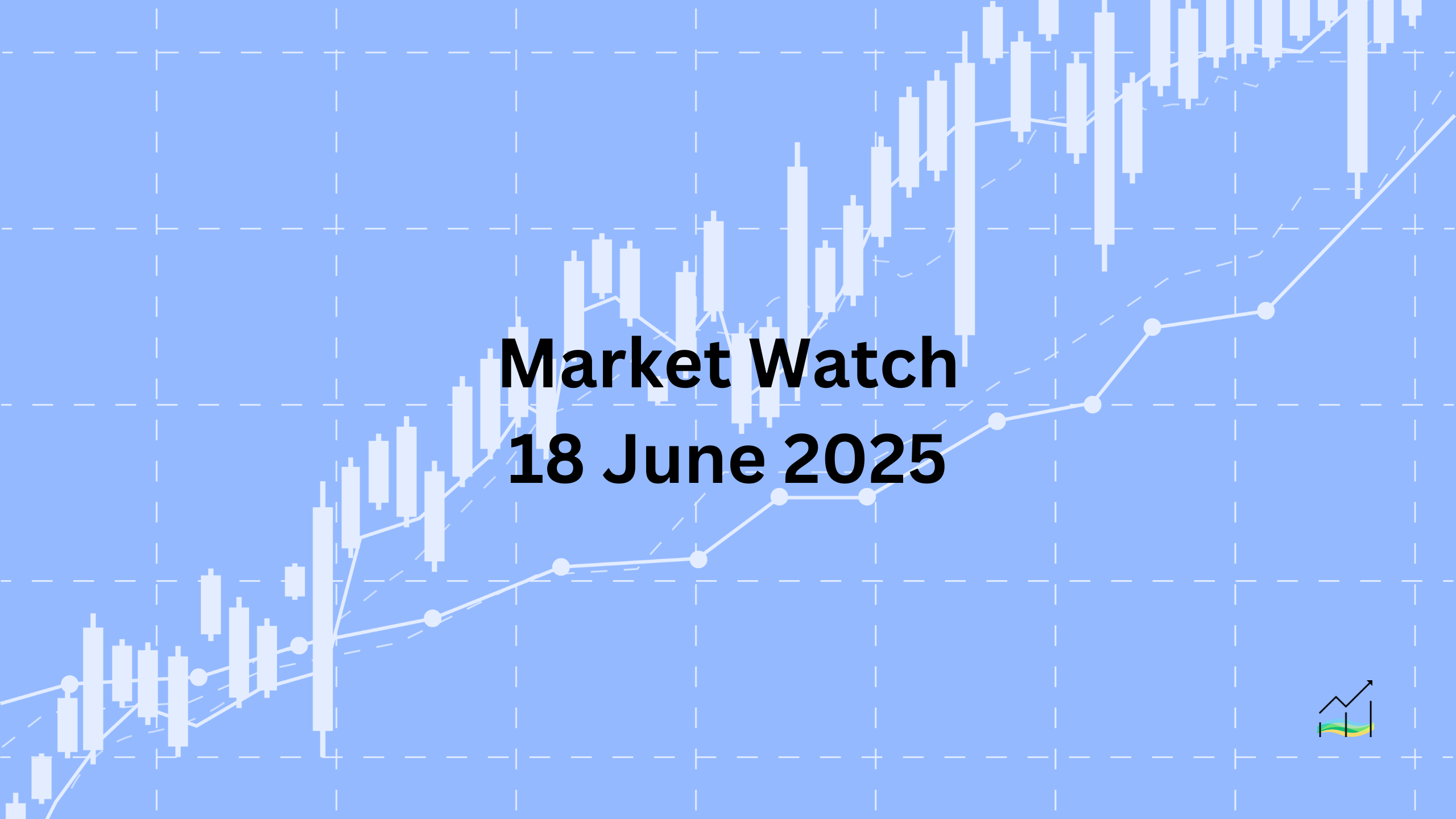18/06/2025 Market Watch

Geopolitical Uncertainty & Central Bank Anticipation
Key Takeaways:
- Dollar buying momentum has eased after yesterday’s North American session.
- Speculation grows about potential US military involvement against Iran; focus remains on upcoming FOMC meeting.
- Dollar strength primarily against Swiss franc, anticipating Swiss National Bank rate decision.
- Mixed performance among Asia-Pacific and European equity markets; modest improvement in US futures.
- Global bond yields mostly softer; gold and oil prices stable within recent ranges.
Yesterday’s strong buying of the US dollar during the North American trading session has moderated, suggesting that traders have completed their short-term adjustments ahead of significant geopolitical developments and central bank announcements. Investors are closely monitoring the possibility of increased US military involvement in the Middle East, particularly regarding Iran. Additionally, attention remains firmly on the outcome of the Federal Open Market Committee (FOMC) meeting, which is set to provide further direction for currency markets.
While follow-up dollar demand is subdued across most major currencies, the US dollar continues to strengthen notably against the Swiss franc. This movement anticipates the Swiss National Bank's policy decision tomorrow, where markets predict a rise in the deposit rate back to zero, reducing the attractiveness of the franc relative to the US dollar. Emerging market currencies reflect a mixed picture; most Asia-Pacific currencies are weaker against the dollar except for the Chinese yuan, while Central European currencies are experiencing modest gains.
Equities have shown mixed performance globally. In Asia-Pacific markets, gains were observed in Japan, Taiwan, and mainland China. Conversely, Hong Kong's Hang Seng index, Australian, and Indian markets registered declines. European equities are relatively flat, as the Stoxx 600 hovers near unchanged levels. Meanwhile, US equity futures suggest a modestly positive open, highlighting cautious optimism.
Global bond yields have edged lower slightly. Europe's benchmark 10-year yields are generally softer, with notably lower yields in the UK and Sweden. The US 10-year Treasury yield is marginally lower, trading close to 4.38%. Commodity markets are showing limited movement, with gold prices trading softer and unable to regain meaningful momentum above the recent key psychological level of $3400 per ounce. Oil prices remain steady, with August WTI trading at the lower end of its recent range, hovering between $72 and $74 per barrel.
United States of America
Overview
The US Dollar Index strengthened yesterday afternoon despite weaker-than-anticipated economic data. May retail sales dropped by 0.9%, and industrial production declined by 0.2%, underscoring softness in recent economic activity. Nonetheless, the dollar managed to reach a four-day high, briefly approaching 98.85 before pulling back slightly below the key 20-day moving average around 99.00. This moving average has proven a tough resistance, remaining unbreached for about a month.
Market participants remain cautious ahead of the Federal Open Market Committee (FOMC) meeting, anticipating no immediate changes to policy. However, traders and investors will closely examine updates in the Fed's Summary of Economic Projections for signals about potential interest rate cuts. Previously, projections indicated two cuts this year, but recent speculation suggests this could be reduced to just one.
The Federal Reserve’s balance sheet remains significantly elevated compared to pre-pandemic levels. Currently standing at $6.67 trillion (approximately 22.5% of GDP), it significantly surpasses the pre-COVID balance of $4.17 trillion (19.2% of GDP). The market is also mindful of the upcoming April Treasury International Capital (TIC) data release, focusing on foreign investment trends in US assets after notable concerns about substantial foreign selling in recent months.
Economic Drivers
- Softer-than-expected US retail sales and industrial output signal cooling economic activity.
- Market speculation surrounding possible revisions to Fed interest rate projections, particularly reducing anticipated cuts from two to one.
- Elevated weekly jobless claims indicating potential softening of labor market conditions.
- Geopolitical concerns related to tariffs and their impact on inflation, though recent CPI reports have consistently underperformed expectations.
- Ongoing market sensitivity to foreign capital flows reflected in TIC data amid recent volatility in US asset demand.
Data and Events
- 18 June 2025: Unemployment Claims.
Price Action
- Dollar Index briefly approached resistance at the 20-day moving average (~99.00) before retreating.
- Early European session witnessed initial support near 98.50, but subsequent gains limited by renewed selling pressure.
- Short-term technical positioning remains cautious ahead of the FOMC meeting, with the index sensitive to shifts in monetary policy expectations.
Key Points:
- Dollar Index gained despite weak economic data.
- Market awaiting crucial signals from the Fed on potential rate cuts.
- Attention focused on the Fed's updated economic projections and quantitative tightening stance.
- US balance sheet remains significantly expanded compared to pre-pandemic levels.
- Upcoming TIC data will clarify foreign appetite for US assets.
Australia
Overview
The Australian dollar reversed its recent upward momentum, declining significantly yesterday to nearly $0.6465. This marked its lowest closing since early June, after previously ending Monday at its strongest level since November. However, the currency found support around these lower levels and has partially rebounded, reaching close to $0.6515.
Market participants are closely awaiting Australia's May employment report, due tomorrow. April data was exceptionally robust, with a notable addition of 89,000 jobs, including 59,500 full-time roles. However, analysts anticipate a moderation in job growth for May, given the exceptional strength seen the previous month. Job creation averaged about 26,000 per month during the first four months of 2025, slightly below the average of nearly 32,000 seen during the same period last year.
Despite stable unemployment rates at 4.1%, workforce participation has notably improved, reaching 67.1% in April 2025 compared to 66.7% a year earlier. The Reserve Bank of Australia's (RBA) future policy moves remain in sharp focus, with markets pricing in approximately an 85% likelihood of a rate cut to 3.60% at its upcoming July meeting. Traders have fully priced in a total of three quarter-point reductions by year's end, reflecting cautious sentiment about Australia's economic outlook.
Economic Drivers
- Moderate expected employment growth following an exceptionally strong April.
- Steady unemployment rate at 4.1%, but improved workforce participation rate (67.1% in April 2025).
- High market expectations for a near-term interest rate cut, signaling anticipated economic easing.
- Rising anticipation of multiple interest rate reductions by the RBA throughout the rest of 2025.
Data and Events
No major economic releases are scheduled today.
Price Action
- AUD reversed sharply, falling to near $0.6465 after a strong start to the week.
- Support held at recent lows, facilitating partial recovery towards $0.6515.
- Volatility remains high ahead of key employment data and anticipated central bank action.
Key Points:
- Australian dollar pulled back significantly after recent strength.
- Employment data in focus, expected moderation after strong April gains.
- Market strongly expects RBA rate cuts, pricing in significant easing.
- Unemployment stable but participation rate improving, highlighting underlying labour market resilience.
Japan
Overview
The Japanese yen experienced increased selling pressure yesterday, with the US dollar advancing toward the JPY145.40 level, marking its highest settlement since mid-May. Early today, the dollar briefly reached a new monthly peak around JPY145.45, maintaining a position near the critical JPY145 mark during European trading hours.
Japan's trade balance worsened notably in May, continuing a historical trend of weakening during this month, barring exceptional years like 2009 and 2020. The trade deficit significantly widened from JPY115.6 billion to approximately JPY638 billion. Exports fell by 1.7% year-over-year, marking the first contraction since September 2024, although the decline was less severe than anticipated.
Imports also dropped sharply by 7.7%, representing the third decline in 2025 and the largest fall since January 2024. A substantial reduction in Japan's trade surplus with the US—from JPY780.40 billion down to JPY451.7 billion—accounted for nearly half the widening deficit.
Meanwhile, core machinery orders, a key indicator of future investment, plunged by 9.1% in April, marking the steepest drop in five years and underscoring a challenging start to the second quarter. While domestic orders shrank significantly by 3.7%, foreign orders surprisingly increased by 6.8%.
Economic Drivers
- Japan’s trade deficit widened sharply in May due to declining exports and imports.
- A pronounced reduction in trade surplus with the US significantly impacted the overall deficit.
- Core machinery orders saw the largest monthly decline in five years, highlighting potential economic softness.
- Divergent trends in machinery orders: domestic orders weakened notably, but foreign demand remained positive.
Data and Events
- 18 June 2025: Core Machinery Orders.
- 18 June 2025: Trade Balance.
Price Action
- USD/JPY climbed above JPY145, marking its highest settlement since mid-May.
- Current trading remains around key resistance near JPY145.45.
- Yen remains under pressure amid persistent dollar strength and weak economic data.
Key Points:
- Yen weakness persists, USD/JPY reaches monthly highs.
- Sharp deterioration in Japan’s trade balance.
- Significant fall in core machinery orders indicating potential economic slowdown.
- Reduced US trade surplus contributing to broader trade deficit.
United Kingdom
Overview
The British pound experienced significant losses yesterday, falling by more than 1%, marking its worst daily performance among major currencies since early April. Sterling declined sharply towards $1.3425, closing below its key technical level (20-day moving average) for the first time since mid-May. Although the currency has managed to regain some ground, recovering to approximately $1.3475 today, sentiment remains cautious amid ongoing concerns over economic fundamentals.
The UK's latest inflation data showed a slight moderation in May, with the annual Consumer Price Index (CPI) easing marginally to 3.4% from the previous month's 3.5%. A notable decline in service-sector inflation, dropping from 5.4% to 4.7%, and a slowdown in core inflation from 3.8% to 3.5% were positive signals. However, despite easing costs for airfares and fuel, persistent inflationary pressures remain evident in rising food, furniture, and household appliance prices. Additionally, goods inflation increased slightly, with retailers hinting at passing along recent hikes in payroll taxes to consumers.
Despite last week's weaker-than-expected economic data showing a 0.3% contraction in UK output for April, markets anticipate no immediate action from the Bank of England (BoE) at tomorrow’s monetary policy meeting. However, market expectations have risen significantly for a possible rate cut by the BoE's subsequent meeting on August 7, with nearly 80% of traders now forecasting such a move.
Economic Drivers
- UK inflation moderating slightly, though core pressures remain persistent.
- Service inflation notably decreased, but ongoing rises in essential consumer goods remain a concern.
- Recent economic weakness, including contraction in April output, heightening market expectations for an eventual interest rate cut.
- Increased likelihood of a rate cut in August based on swaps market pricing (now near 80%).
Data and Events
- 18 June 2025: CPI.
Price Action
- GBP sharply declined to near $1.3425, breaching key technical support levels.
- Current recovery limited, with resistance seen near $1.3520 necessary to stabilize technical outlook.
- Potential bearish crossover looming between five-day and 20-day moving averages, signaling caution.
Key Points:
- Sterling suffered significant daily losses, hitting lowest levels since mid-May.
- Inflation easing slightly but persistent underlying pressures remain.
- Rising market anticipation of rate cut by BoE, particularly by August.
- Economic data weakness increasing pressure on Sterling sentiment.
© 2025 SKONE Enterprise (003319453-V). All rights reserved.
The content on this site is for informational purposes only and does not constitute financial advice.


